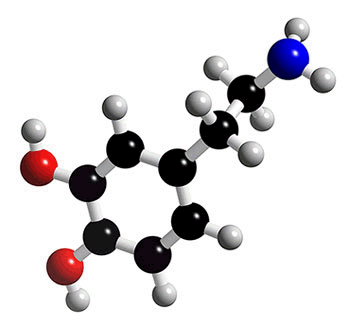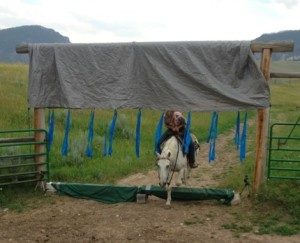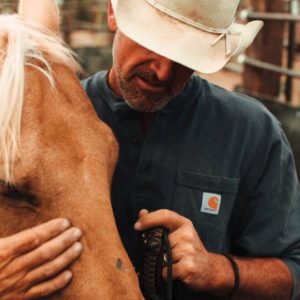 For years, horse owners and riders have gravitated to the black-and-white straightforwardness of the dopamine response. Licking, chewing, and associated manifestations of this feel-good neurochemical are simple, visible indices of the horse’s state of mind.
For years, horse owners and riders have gravitated to the black-and-white straightforwardness of the dopamine response. Licking, chewing, and associated manifestations of this feel-good neurochemical are simple, visible indices of the horse’s state of mind.
But, as with everything, there are finer points and nuance to what, at first glance, is a simple concept. At least one trainer believes simple can quickly turn to over-simplified and be of great disservice to the horse.
Too often, says Best Horse Practices Summit presenter Amy Skinner, the rider may train her horse to routinely seek escape instead of relaxation. “I see a lot of people rewarding the wrong thing or training a horse to get in the habit of tolerating a request because at the end there will be relief.”
Since HorseHead is a blog dedicated to flushing out the intricacies of brain science, we want to explore the finer points of dopamine-related training.
For a review of dopamine and the science behind pressure-and-release training, also known as negative reinforcement, read more here.
Consider a human scenario:
 Skinner gets uncomfortable at crowded parties. “I get a big dopamine release when I’m finally at home, having left the party. But it would be a better learning experience for me, really, if someone could nurture my ability to enjoy the party, to find a dopamine release within a big, crowded situation. Without that kind of training, more exposure to parties doesn’t make me enjoy them more. It makes me resent them more. I may learn ‘acceptable behavior’ so I can get out of there faster. I think a lot of horses do this with training.”
Skinner gets uncomfortable at crowded parties. “I get a big dopamine release when I’m finally at home, having left the party. But it would be a better learning experience for me, really, if someone could nurture my ability to enjoy the party, to find a dopamine release within a big, crowded situation. Without that kind of training, more exposure to parties doesn’t make me enjoy them more. It makes me resent them more. I may learn ‘acceptable behavior’ so I can get out of there faster. I think a lot of horses do this with training.”
Similarly, she likes to encourage horses to find relaxation (licking, chewing, breathing in a relaxed way) during the request or exercise. She pays particular attention to a horse’s breathing. She’d like it to be rhythmic, not shallow. The horse’s barrel is soft and its legs move freely. The eye and nostril are relaxed.
“Like someone in a yoga class. Active, engaged, but relaxed,” she said.
Some indications that a horse may not be engaged:
- Does the horse doing passage (an energetic, elevated trot in dressage) have its ears back or forward? They should be forward.
- Does the horse trip while performing a request?
 Best Horse Practices Summit presenter Dr. Steve Peters weighs in:
Best Horse Practices Summit presenter Dr. Steve Peters weighs in:
I agree with Amy that there is a big difference in learning in a relaxed state and finding relief versus escape from pressure. However, dissociation, involvement of the amygdala, and creating good learning experiences are all relevant here. What’s needed is a more nuanced understanding of dopamine reinforcement.
The more I study the horse’s brain and nervous system, the more clear it becomes to me how horses process and what state they need to be in to optimize this processing.
We all know that we need to have their attention. Horses are not with us when bored, distracted or stressed. But when stressed, they will often dissociate or check out. They may still hear our message to some extent, but they are not comfortable in their nervous system (e.g., jaw is still tight, eyes not focused, etc). Some messages we’re sending are getting hijacked by the amygdala. The horse dissociates and we are no longer in sync, although the horse may appear calm. If you look closely, you’ll see they are not comfortable in their bodies. Read more about Attention here.
I feel that one of the critical underlying issues for our horsemanship is showing the horse how to get to a safe internal state. It is never about the tarp or the trailer or the trail.
 We need to show our horses how to search and find this safe state no matter what is going on around them. The safe state is when messages are going through the motor sensory system and bypassing the amygdala.
We need to show our horses how to search and find this safe state no matter what is going on around them. The safe state is when messages are going through the motor sensory system and bypassing the amygdala.
A note about disassociation from Dr. Peters:
As a neuropsychologist, sometimes I have the challenge of delivering a terminal diagnosis to patients. I see their minds go blank. They dissociate. The fear messages from the limbic system overwhelm them. They gloss over anything I say because they’ve essentially short-circuited the frontal lobe.
Often, the best thing I can do is simply reach out and put my hand on their shoulder to reconnect. Words would be useless and not helpful.
I encourage riders to do work consistent with the way horses’ brains and nervous systems work. Lead line work can be especially helpful with connection through sensory messages that the horse can feel and understand. When the message is clear, the horse can began to find safety in it. They become comfortable in their body. We also know that extra, ‘message-free’ dwell time helps learning. Message-free time in our training allows the horse to make associations, consolidate information, and get the biggest dopamine reinforcement. Read more about Dwell Time.
 Best Horse Practices Summit presenter West Taylor works almost exclusively with wild horses and shared these insights:
Best Horse Practices Summit presenter West Taylor works almost exclusively with wild horses and shared these insights:
Creating the dopamine release is all we focus on here at my place. It’s not about getting a halter on a horse. It’s about how many times the trainer can get the horse to lick and chew, thus leaving a result that the halter will end up on the horse.
I feel the horse is constantly asking the question of “Am I Safe?” These are some “Am I Safe?” questions:
- Raising of the head
- Turning the head
- Moving the feet
The more times I can create a dopamine release of “YES” to this question of safety, the calmer and quieter the horse becomes.
I’m working with wild horses, so this question of safety is at the highest level. I may create 30 dopamine releases before I get the halter on a wild one. For a more confident mustang, I may only be able to create a handful of releases before I get the halter on.
The same principle applies to leading, saddling, trailering, packing, etc. It’s not about the saddle. It’s about how many dopamine releases I can create before I actually saddle the horse. This approach of focusing on creating the dopamine release rather than saddling the horse causes us to release pressure a lot more often. In that way, we create a calmer, quieter horse.
For example:
I just spent two hours with a very cautious mustang, assisting him in finding safety while loading in the trailer. He was very explosive about even being presented with the idea of loading. He would pull back and explosively back up until he was completely away from the trailer.
In a period of two hours, I created 174 Dopamine (measured by licking and chewing) releases before he loaded himself in the trailer. I feel that he created a “feel good” path from wherever I could first get him to lick and chew, all the way into the trailer. We paused with each step or hint of curiosity all along the way. This took patience on my part and curiosity from the mustang.
I feel this dopamine process will make a lasting change in his mind.
Brilliant! I guess I have used this without knowing what it was. I have developed a process for loading nervous TBs that works for me. They have all been loaded before. They all get too nervous to look at the trailer or move towards it. Starting a fight only makes it worse. I just let them stop and put a hand across their neck, talking softly and breathing deep until they are ready to continue for a step or two. The process ends when they are inside munching hay.
Really lovely descriptions of getting a dopamine release in your horse’s brain without having the “checked out” version of your horse. All the article contributors are spot on….fantastic!!
Lovely! Thank you for a great read. I am so excited about Neuroscience and horses – understanding ‘why’ makes the ‘how’ happen by feel in the moment rather than following a set plan that may not be suited to that horse or the moment. Thank you, I am looking forward to exploring more on this site!
You might enjoy the Best Horse Practices Summit where we will explore horse brain chemistry. Email us if you’d like more info.
This is one of the clearest explanations I have come across. It’s so helpful. And seeing West with the mustangs is a great opportunity to see more of what he explains in ACTION.
I am looking forward to the Best Horse Practices Summit in Maine this year!
Exciting, relevant and immeditaly useful ways of change with the horse….beautiful.
Wow… this is very powerful!